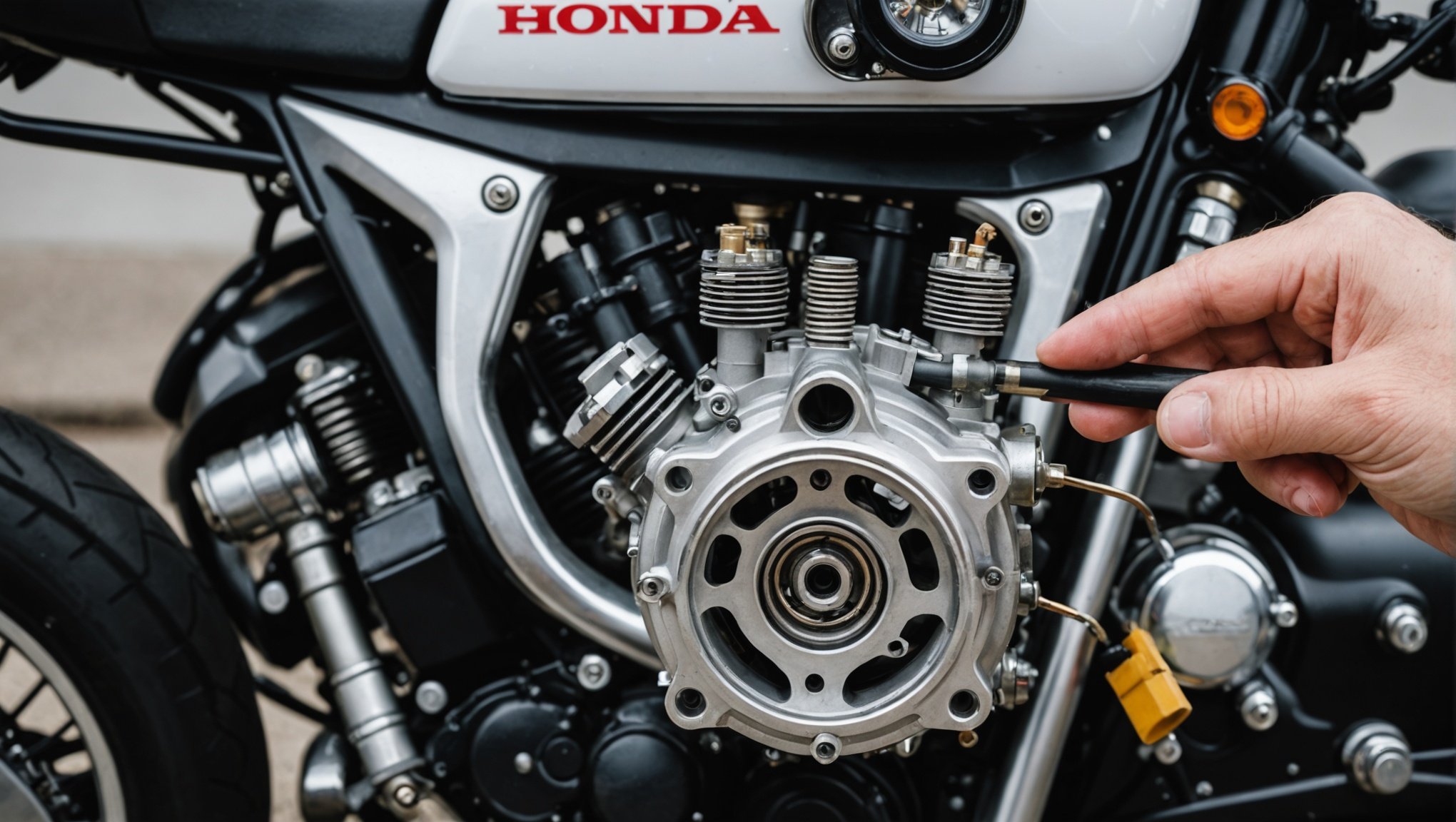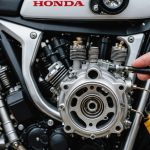Optimizing your Honda CB500F’s carburetor can transform your riding experience. The pilot screw adjustment plays a vital role in achieving that perfect balance between performance and efficiency. Improper settings can lead to frustrating issues like poor throttle response and reduced fuel efficiency. This guide offers essential tips to master your pilot screw adjustment, ensuring your motorcycle runs smoothly and performs at its best. Dive in and unlock the full potential of your ride!
Understanding the Honda CB500F Carburetor
The Honda CB500F carburetor plays a crucial role in the overall engine performance by mixing air and fuel in the right proportions. This component is composed of several parts, each contributing to its efficient function. Among these, the pilot screw is particularly important. It regulates the air-fuel mixture at idle and low-speed conditions, directly impacting the engine’s smoothness and responsiveness.
Have you seen this : Transform your motorcycle with unique graphic designs
Carburetor adjustments are essential for maintaining optimal engine performance. When the air-fuel mixture is too rich or too lean, it can lead to poor combustion, affecting the bike’s power and efficiency. Adjusting the Honda CB500F carburetor can enhance throttle response and fuel economy.
Understanding the function of each component, especially the pilot screw, is vital. This knowledge helps in diagnosing performance issues and making necessary adjustments. Properly tuned, the carburetor ensures the engine runs efficiently, delivering the expected power output while maintaining fuel efficiency.
Topic to read : Can I modify the seat height of a Kawasaki Ninja 400 for a shorter rider?
Regular maintenance and adjustments of the Honda CB500F carburetor can prevent common issues like stalling or rough idling, ensuring a smooth and enjoyable ride. By focusing on the carburetor’s function, riders can significantly enhance their motorcycle’s performance.
The Role of the Pilot Screw
Understanding the pilot screw function is essential for maintaining the fuel mixture and ensuring engine efficiency. The pilot screw primarily controls the amount of air that mixes with fuel at idle and low-speed conditions. This adjustment is crucial because it directly influences the air-fuel mixture, which affects how smoothly the engine runs.
Pilot Screw and Air-Fuel Mixture
The relationship between the pilot screw and the air-fuel mixture is significant. By turning the screw, you can either enrich or lean the mixture. A richer mixture means more fuel and less air, while a leaner mixture involves more air and less fuel. This balance is vital for optimal combustion, affecting the bike’s performance and fuel economy.
Impact on Engine Idle and Performance
Proper pilot screw settings can significantly impact engine idle and overall performance. If the mixture is too rich or too lean, the engine may stall or idle roughly. Adjusting the pilot screw helps achieve a stable idle and enhances throttle response. This ensures that the engine runs efficiently, providing a smooth and responsive ride. Understanding these adjustments can help diagnose and resolve performance issues, leading to a more enjoyable riding experience.
Tools Required for Adjustment
Before adjusting the Honda CB500F carburetor, having the right tools for carburetor adjustment is essential. These tools ensure precision and safety during the process.
Essential Tools for Adjustment
To adjust the pilot screw effectively, you’ll need a basic toolkit. This includes:
- Screwdrivers: A flathead screwdriver is crucial for turning the pilot screw.
- Wrenches: Various sizes may be needed to access and remove parts.
- Carburetor adjustment tool: A specialized tool that can reach tight spaces.
Recommendations for Quality Tools
Investing in quality tools can make a significant difference. Brands like Craftsman and Snap-on are renowned for their durability and precision. These tools ensure that adjustments are made accurately, which is critical for maintaining engine performance.
Safety Equipment and Considerations
Safety is paramount when working on the carburetor. Always wear protective gloves to prevent burns and cuts. Safety goggles are also recommended to protect your eyes from fuel splashes or debris. Additionally, ensure that the motorcycle is on a stable surface to prevent accidents. By using the right necessary equipment and adhering to safety precautions, you can adjust the carburetor confidently and effectively.
Step-by-Step Guide to Adjusting the Pilot Screw
Adjusting the pilot screw is a precise process that requires attention to detail. This step-by-step guide will walk you through the adjustment technique to ensure optimal performance of your Honda CB500F.
Locating the Pilot Screw
First, identify the pilot screw on the carburetor. It is usually found on the side, near the base. Refer to your motorcycle’s manual for the exact location, as it can vary slightly.
Adjustment Process
- Preparation: Ensure the engine is off and cooled down. Gather your tools, including a flathead screwdriver.
- Initial Setting: Turn the pilot screw clockwise until it lightly seats. Then, turn it counterclockwise by the recommended number of turns specified in the manual, usually 1.5 to 2 turns.
- Incremental Adjustments: Start the engine and let it idle. Make small, incremental adjustments to the pilot screw, about a quarter turn at a time. Listen to the engine’s response, aiming for a smooth and stable idle.
- Testing: After each adjustment, rev the engine slightly to test throttle response. Ensure the engine does not stall or idle roughly.
Importance of Incremental Adjustments
Making incremental adjustments is crucial. It allows you to fine-tune the air-fuel mixture without causing sudden changes in engine performance. This careful approach ensures a balanced and efficient engine operation.
Common Mistakes to Avoid
Adjusting the pilot screw on your Honda CB500F carburetor can significantly enhance performance, but it’s crucial to avoid common pitfalls. Missteps during this process can lead to suboptimal engine function.
Frequent Adjustment Errors
One of the most common errors is over-adjustment. Turning the pilot screw too much in either direction can disrupt the air-fuel mixture, leading to a rough idle or even stalling. Always make incremental adjustments and observe the engine’s response.
Troubleshooting Tips
When troubleshooting, listen for irregular engine sounds or performance issues. If the engine idles roughly, it may indicate the mixture is too rich or too lean. Use these signs to guide your adjustments.
- Recheck Initial Settings: Ensure the pilot screw is set to the manufacturer’s recommended position before starting adjustments.
- Monitor Engine Temperature: Adjustments should be made when the engine is at operating temperature for accuracy.
Importance of Proper Tuning
Proper tuning is essential for optimal performance. An accurately adjusted pilot screw ensures a balanced air-fuel mixture, enhancing throttle response and fuel efficiency. Avoiding common pitfalls and using these troubleshooting tips can lead to a smoother, more reliable ride.
Diagnosing Issues Related to Pilot Screw Settings
Troubleshooting carburetor issues can be daunting, especially when performance problems arise due to incorrect pilot screw settings. Recognising symptoms early can prevent further complications.
Symptoms of Incorrect Pilot Screw Settings
Incorrect pilot screw settings often manifest as rough idling, stalling, or poor throttle response. A lean mixture can cause the engine to overheat or backfire, while a rich mixture might lead to black smoke from the exhaust and fouled spark plugs. These symptoms indicate the need for pilot screw diagnostics.
Methods for Diagnosing Carburetor-Related Issues
Begin by checking the initial position of the pilot screw. If symptoms persist, perform a pilot screw diagnostics by making small adjustments and observing changes in engine behaviour. Listening for irregular sounds or noting performance changes can guide further adjustments. Ensure the engine is at operating temperature for accurate diagnostics.
When to Seek Professional Help for Carburetor Problems
If troubleshooting does not resolve the issues, it may be time to seek professional assistance. Persistent performance problems or complexity beyond basic adjustments warrant expert evaluation. A professional can provide a thorough inspection and precise tuning, ensuring optimal engine performance and longevity.
Impact of Environmental Factors on Adjustments
Understanding the environmental effects on your Honda CB500F’s carburetor is essential for optimal performance. Altitude adjustments and temperature considerations play significant roles in maintaining the right air-fuel mixture.
Altitude Effects on Pilot Screw Settings
Altitude significantly impacts the air density, affecting the carburetor’s performance. At higher altitudes, the air is thinner, requiring a leaner air-fuel mixture. This means adjusting the pilot screw to reduce fuel flow and compensate for the reduced oxygen. Conversely, at lower altitudes, a richer mixture might be necessary to ensure efficient combustion.
Adjusting for Seasonal Temperature Changes
Temperature variations can also affect carburetor settings. Colder temperatures increase air density, necessitating a richer mixture for optimal performance. Conversely, warmer conditions may require leaning the mixture slightly. Regularly adjusting the pilot screw for seasonal changes ensures smooth engine operation and prevents performance issues.
Importance of Tuning for Specific Riding Conditions
Consider the specific riding conditions you frequently encounter. Whether you’re riding in mountainous regions or varying climates, tuning the carburetor accordingly is crucial. By understanding and adjusting for these environmental effects, you can maintain engine efficiency and enjoy a consistent riding experience. Regular tuning based on altitude and temperature ensures your motorcycle performs optimally, regardless of the conditions.
Enhancing Fuel Efficiency Through Proper Adjustments
Improving fuel efficiency on your Honda CB500F is closely linked to pilot screw optimization. Properly adjusting the pilot screw can significantly impact the bike’s overall performance and fuel consumption.
Connection Between Pilot Screw Settings and Fuel Economy
The pilot screw plays a crucial role in fine-tuning the air-fuel mixture, which directly affects fuel efficiency. A well-adjusted screw ensures optimal combustion, reducing fuel wastage and enhancing performance. By achieving the right balance, riders can enjoy longer rides with fewer refuels.
Tips for Achieving Maximum Efficiency During Adjustments
To optimize performance, start with the manufacturer’s recommended pilot screw settings. Make incremental adjustments while monitoring the engine’s response. A smooth idle and responsive throttle indicate an efficient mixture. Regularly check and adjust based on riding conditions and environmental factors to maintain peak fuel efficiency.
Real-World Examples of Fuel Savings Through Proper Tuning
Many riders report noticeable improvements in fuel economy after fine-tuning their carburetor settings. For instance, a rider adjusting for altitude changes noted a 10% increase in mileage. Such examples underscore the importance of pilot screw optimization in achieving cost-effective and environmentally friendly riding.
Visual Aids for Adjustment
Visual aids can significantly enhance your understanding of carburetor adjustments on the Honda CB500F. They provide clear, step-by-step guidance, making the process more intuitive and less daunting. Diagrams and instructional images are invaluable tools for visual learners, offering a detailed view of the carburetor’s components and adjustment points.
Recommended Diagrams and Images
When working on the pilot screw or other parts of the carburetor, having access to accurate diagrams is essential. Look for visuals that label each component clearly and show the sequence of adjustments. High-quality images can help you identify parts like the pilot screw, ensuring you make precise adjustments.
Where to Find Reliable Instructional Visuals Online
There are several online resources where you can find reliable adjustment visuals. Websites dedicated to motorcycle maintenance, forums, and even video platforms often provide comprehensive guides with detailed images. Ensure the sources are reputable and the visuals are clear and detailed. Manufacturer websites or official service manuals are excellent starting points for finding accurate and trustworthy diagrams. Using these resources will help you confidently perform adjustments, enhancing your motorcycle’s performance.
Resources for Further Learning
Expanding your knowledge on carburetor tuning can significantly enhance your motorcycle maintenance skills. Accessing additional resources is key to mastering these adjustments.
Books, Articles, and Websites
Several learning materials can deepen your understanding of carburetor tuning. Books like “The Motorcycle Carburetor Manual” offer in-depth insights. Online articles from reputable motorcycle maintenance sites provide practical tips and updates on best practices. Websites such as Motorcycle Maintenance Hub are excellent for detailed guides and expert advice.
Forums and Communities
Joining forums and communities for motorcycle enthusiasts is invaluable. Platforms like Motorcycle Forum and Reddit’s r/motorcycles connect you with fellow riders and experts. These spaces offer a wealth of shared experiences, troubleshooting tips, and advice on carburetor adjustments.
Importance of Continuous Learning
Staying updated with expert guides and resources ensures you remain informed about the latest techniques and tools. Continuous learning is crucial in adapting to new technologies and methodologies in motorcycle maintenance. Engaging with the community and exploring various resources helps you refine your skills, ensuring your Honda CB500F performs optimally. By leveraging these additional resources, you can confidently tackle any carburetor-related challenges.
















